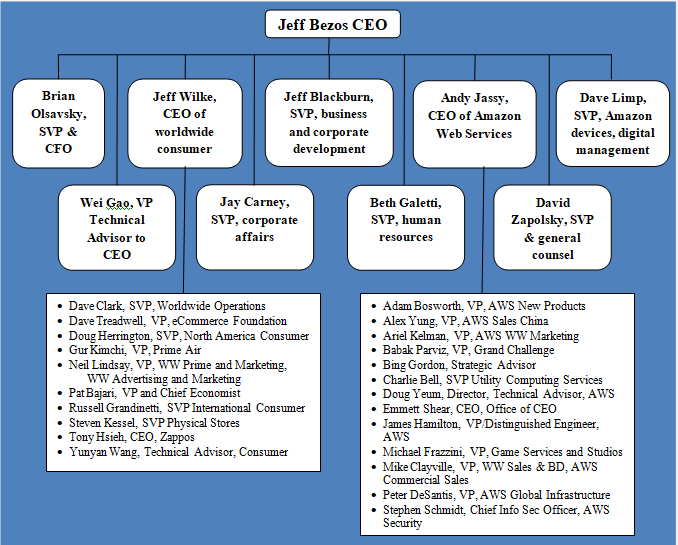Name of the organization and its founder
Jeffrey Preston Bezos, an American proprietor, internet entrepreneur, and industrialist, is the founder and CEO of Amazon. Bezos has worked as Amazon’s CEO for 27 years since he founded it in 1994 (Hall 2). Bezos has seen Amazon grow into one of the largest companies in tech. As he is set to step down from leadership later this year, his administration has been one of the best.
Amazon’s brief history
Amazon was founded on July 5, 1994, by Bezos in Bellevue, Washington. Its first version launched in 1994 was under the name “Cadabra,” which later changed to Amazon following advice from Bezos’ lawyers. Amazon started as a bookseller with the aim of delivering books to any address conveniently. Around 1998, the company expanded into selling video games and music after pursuing Bezos’ initial business strategy. Around the same time, Amazon began expanding its international offerings by acquiring online bookstores in Germany and the United Kingdom (Hall 2). Amazon had grown to sell home products, consumer electronics, software, video games, toys, and much more by the turn of the millennium.
Amazon introduced its Amazon Web Services (AWS) in the mid-2000s, following Bezos’ original goal of turning Amazon into a tech business rather than just an online retailer. Amazon’s Elastic Compute Cloud (EC2) was added to the AWS portfolio in 2006. (EC2). The company released its first Kindle e-readers in 2007 further diversifying its products. The e-book market would be revitalized by these comparatively low-cost portable devices, and by 2012, the Kindle would account for roughly half of all Android-operated tablet sales (Hall 2). Since that time, Amazon has continually diversified its products. Fresh produce shipping, drone delivery, and a slew of other innovations are among its many innovations.
Jeff Bezos’ brief history and decision scope
Bezos, who was born in New Mexico in 1964, developed an early interest in computers and went on to Princeton University to study computer science and electrical engineering. He worked on Wall Street after graduation, rising to the position of youngest senior vice president at D.E. Shaw in 1990 (Hall 2). Bezos left his well-paid job four years later to launch Amazon.com. Since then, Bezos has been following his initial business plan and moving the company closer to his vision. He bought The Washington Post in 2013 and Whole Foods in 2017. In February 2021, the company announced that Bezos would step down from the CEO position giving room for new leadership at Amazon.
From figure 8.2 provided, Jeff Bezos falls into the broad decision scope. This scope reflects top management’s decision-making traits, which is where Bezos fits. Being the founder and CEO of Amazon, Bezos has made decisions that have impacted the company’s future, such as the acquisition of online bookstores in the U.K. He carries a heavy responsibility for the company’s decision-making process. He has demonstrated a high degree of accountability, and all the decisions he has made have contributed to Amazon’s success.
Elements of decision-makers found in Bezos
Page 174 of the given text highlights several elements of decision-makers demonstrated by leaders at various levels. Out of the five main elements discussed, Bezos fits the receptive and marketing-oriented decision-makers. The receptive decision-makers are characterized by viewing success as outside themselves. Receptive decision-makers are good listeners and rely on expert advice to make good decisions. Since they are willing to succeed, they allow other people to give their opinions on the best alternatives.
Bezos demonstrated the receptive orientation at the time of choosing a name for his company. Initially, he wanted the company to be called “Cadabra.” However, his lawyers advised against it following instances of misinterpretation. To this, Bezos agreed and changed the name to Amazon.
The marketing-oriented decision-making trait is seen in Bezos’ business strategies. Every business strategy made by Bezos reflected the idea that he saw himself as valuable as his decisions. He was careful not to ruin his business by relying on ineffective methods. First, he quit a lucrative job and started Amazon from scratch because he wanted to pursue his mission and vision. Second, when he realized that the name “Cadabra” would have a negative impact on his business, he quickly changed it. Third, he has considered stepping down from leadership after 27 successful years as Amazon’s CEO. He wants to leave a good legacy and not interfere with the fresh administration at Amazon. These traits show that Bezos holds his decisions in high regard because he believes they determine the success of his life and business.
Amazon’s decision-making process during the COVID-19 pandemic
During the pandemic, Amazon’s leadership followed a programmed decision-making process and quickly strategized on increasing the effectiveness of its online operations. At the onset of the pandemic, the company realized that the pandemic would have far-fetching effects. Bezos suspended his work on his rocket company, Blue Origin, and focused all his attention on Amazon’s operations.
Amazon’s leaders embarked on employee recruitment as a strategic move to cater to the increased demand for basic supplies such as sanitizers and face masks. Amazon had set aside at least $700 million for employee training and workforce improvement and hired an additional 175,000 workers (Hall 2). The employee increase was a creative and innovative strategy that ensured Amazon’s success and sustainability. Most of the leaders who pioneered this decision during the pandemic had worked at Amazon for over a year, implying that their judgments were well-informed. The decision-making process followed by Amazon includes analyzing the problem, finding all the relevant alternatives, and selecting the optimal choice.
Recent Organizational Chart

Work Cited
Hall, Mark. “Amazon.” Encyclopedia Britannica. Web.
